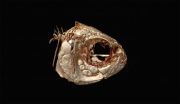(Press-News.org) CORVALLIS, Ore. – In a recent advance in solar energy, researchers have discovered a way to tap the sun not only as a source of power, but also to directly produce the solar energy materials that make this possible.
This breakthrough by chemical engineers at Oregon State University could soon reduce the cost of solar energy, speed production processes, use environmentally benign materials, and make the sun almost a "one-stop shop" that produces both the materials for solar devices and the eternal energy to power them.
The findings were just published in RSC Advances, a journal of the Royal Society of Chemistry, in work supported by the National Science Foundation.
"This approach should work and is very environmentally conscious," said Chih-Hung Chang, a professor of chemical engineering at Oregon State University, and lead author on the study.
"Several aspects of this system should continue to reduce the cost of solar energy, and when widely used, our carbon footprint," Chang said. "It could produce solar energy materials anywhere there's an adequate solar resource, and in this chemical manufacturing process, there would be zero energy impact."
The work is based on the use of a "continuous flow" microreactor to produce nanoparticle inks that make solar cells by printing. Existing approaches based mostly on batch operations are more time-consuming and costly.
In this process, simulated sunlight is focused on the solar microreactor to rapidly heat it, while allowing precise control of temperature to aid the quality of the finished product. The light in these experiments was produced artificially, but the process could be done with direct sunlight, and at a fraction of the cost of current approaches.
"Our system can synthesize solar energy materials in minutes compared to other processes that might take 30 minutes to two hours," Chang said. "This gain in operation speed can lower cost."
In these experiments, the solar materials were made with copper indium diselenide, but to lower material costs it might also be possible to use a compound such as copper zinc tin sulfide, Chang said. And to make the process something that could work 24 hours a day, sunlight might initially be used to create molten salts that could later be used as an energy source for the manufacturing. This could provide more precise control of the processing temperature needed to create the solar energy materials.
State-of-the-art chalcogenide-based, thin film solar cells have already reached a fairly high solar energy conversion efficiency of about 20 percent in the laboratory, researchers said, while costing less than silicon technology. Further improvements in efficiency should be possible, they said.
Another advantage of these thin-film approaches to solar energy is that the solar absorbing layers are, in fact, very thin - about 1-2 microns, instead of the 50-100 microns of more conventional silicon cells. This could ease the incorporation of solar energy into structures, by coating thin films onto windows, roof shingles or other possibilities.
INFORMATION:
Additional support for this work was provided by the Oregon Nanoscience and Microtechnologies Institute, or ONAMI, and the Oregon Built Environment and Sustainable Technologies Center, or Oregon BEST.
Editor's Note: A graphic to illustrate this new technology is available online: http://bit.ly/1i2JXqV
Energy breakthrough uses sun to create solar energy materials
2014-04-03
ELSE PRESS RELEASES FROM THIS DATE:
New tweetment: Twitter users describe real-time migraine agony
2014-04-03
ANN ARBOR—Someone's drilling an icicle into your temple, you're throwing up, and light and sound are unbearable.
Yes, it's another migraine attack. But now in 140 characters on Twitter, you can share your agony with other sufferers. It indicates a trend toward the cathartic sharing of physical pain, as well as emotional pain on social media.
"As technology and language evolve, so does the way we share our suffering," said principal investigator Alexandre DaSilva, assistant professor and director of the Headache and Orofacial Pain Effort at University of Michigan School ...
Indigenous societies' 'first contact' typically brings collapse, but rebounds are possible
2014-04-03
It was disastrous when Europeans first arrived in what would become Brazil -- 95 percent of its population, the majority of its tribes, and essentially all of its urban and agricultural infrastructure vanished. The experiences of Brazil's indigenous societies mirror those of other indigenous peoples following "first contact."
A new study of Brazil's indigenous societies led by Santa Fe Institute researcher Marcus Hamilton paints a grim picture of their experiences, but also offers a glimmer of hope to those seeking ways to preserve indigenous societies.
Even among ...
NASA's Aqua satellite flies over newborn Tropical Depression 05W
2014-04-03
The fifth tropical depression of the northwestern Pacific Ocean tropical cyclone season formed far from land as NASA's Aqua satellite passed overhead and captured a visible image of the storm on April 4.
NASA's Aqua satellite passed over newborn Tropical Depression 05W on April 3 at 03:10 UTC/April 2 at 11:10 p.m. EDT. The Moderate Resolution Imaging Spectroradiometer or MODIS instrument captured a visible picture of the storm, revealing good circulation and strong convection and thunderstorms around the center of circulation.
The Joint Typhoon Warning Center or JTWC ...
Sanford-Burnham presents cancer research at AACR
2014-04-03
LA JOLLA, Calif., April 3, 2014 — Sanford-Burnham Medical Research Institute will present a wide range of new research data at the annual American Association for Cancer Research Meeting in San Diego starting Saturday, April 5, at the San Diego Convention Center. The presentations will cover a variety of topics including breast, melanoma, and prostate cancer, as well as novel methods of delivering drugs to tumors.
If you are interested in interviewing a Sanford-Burnham researcher, please contact Susan Gammon at sgammon@sanfordburnham.org.
Highlights of Sanford-Burnham's ...
A new approach to detecting changes in GM foods
2014-04-03
Does genetic manipulation causes unintended changes in food quality and composition? Are genetically modified (GM) foods less nutritious than their non-GM counterparts, or different in unknown ways?
Despite extensive cultivation and testing of GM foods, those questions still linger in the minds of many consumers. A new study in the March issue of The Plant Genome demonstrates a potentially more powerful approach to answering them.
In research led by Owen Hoekenga, a Cornell University adjunct assistant professor, scientists extracted roughly 1,000 biochemicals, or "metabolites," ...
Quantum cryptography for mobile phones
2014-04-03
Secure mobile communications underpin our society and through mobile phones, tablets and laptops we have become online consumers. The security of mobile transactions is obscure to most people but is absolutely essential if we are to stay protected from malicious online attacks, fraud and theft.
Currently available quantum cryptography technology is bulky, expensive and limited to fixed physical locations – often server rooms in a bank. The team at Bristol has shown how it is possible to reduce these bulky and expensive resources so that a client requires only the ...
Fermi data tantalize with new clues to dark matter
2014-04-03
VIDEO:
This animation zooms into an image of the Milky Way, shown in visible light, and superimposes a gamma-ray map of the galactic center from NASA's Fermi. Raw data transitions to...
Click here for more information.
A new study of gamma-ray light from the center of our galaxy makes the strongest case to date that some of this emission may arise from dark matter, an unknown substance making up most of the material universe. Using publicly available data from NASA's Fermi Gamma-ray ...
Which couples who meet on social networking sites are most likely to marry?
2014-04-03
New Rochelle, NY, April 3, 2014—Nearly 7% of Americans married between 2005-2012 met on social networking sites. How those couples compare to couples who met through other types of online meetings or the "old-fashioned" way in terms of age, race, frequency of Internet use, and other factors is explored in an article in Cyberpsychology, Behavior, and Social Networking, a peer-reviewed journal from Mary Ann Liebert, Inc., publishers. The article is available free on the Cyberpsychology, Behavior, and Social Networking website.
In "First Comes Social Networking, Then Comes ...
Sage grouse losing habitat to fire as endangered species decision looms
2014-04-03
As fires sweep more frequently across the American Great Basin, the US Bureau of Land Management (BLM) has been tasked with reseeding the burned landscapes to stabilize soils. BLM's interventions have not helped to restore habitat for the greater sage grouse (Centrocercus urophasianus) reported scientists from the US Geological Survey (USGS) and US Forest Service in the Ecological Society of America's journal Ecosphere last week, but outlier project sites with good grouse habitat may yield clues to successful management scenarios.
Their report arrives in the shadow of ...
Examination of a cave-dwelling fish finds a possible genetic link to human disorders
2014-04-03
Researchers have identified a genetic association with facial asymmetry in an ancient cavefish, a natural trait that may solve mysteries surrounding facial asymmetries in humans – conditions such as cleft palate or hemifacial microsomia. This exciting discovery by Joshua Gross, a University of Cincinnati assistant professor for the Department of Biological Sciences; and doctoral students Amanda Krutzler and Brian Carlson, is published in the research journal, Genetics.
The researchers are studying the craniofacial features of the eyeless, cave-dwelling fish, Astyanax ...





